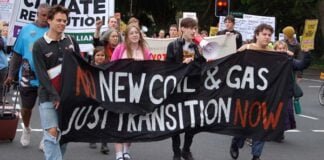The campaign to stop new coal power stations is shaping up as one of the key issues for the climate movement—both in NSW and nationally.
In early March the NSW government gave “concept approval” for plans to build two new coal-fired power stations—one in the Hunter Valley and one at Lithgow. But there is still plenty of time to stop them going ahead. The government plans to sell the development sites for the two power stations together with the approval to build. It wants the private sector to build and run the new power stations. But it still has to find an interested buyer.
Delays to its power privatisation plans, where the government hopes to sell retail electricity companies and the “trading rights” to power produced in state owned generators, show that this will not be easy. The development sites for the new power plants are to be sold as part of the privatisation process.
In February the government announced a six month delay to power privatisation, abandoning its original schedule of completing the sale by June. As the Financial Review revealed, “Sources close to the government said the main reason for the delay was that it was waiting for additional competition in the process”. In other words there were not enough bidders.
This is good news for the campaign. The government had hoped to sneak the plans for new power stations through and avoid public attention. It released the environmental approval the same day as Kevin Rudd’s major announcement about his health takeover, hoping to avoid media coverage.
If the new power plants go ahead they will add 15 per cent to NSW’s total emissions. Even gas plants would add 7 per cent to emissions. And a report by independent consultants Arup found that emissions from the Mt Piper plant “could be up to 20% higher than the values presented in the greenhouse gas estimate”.
These emissions would be locked in for 30 years, the life of a power station.
Research by Greenpeace has revealed that there are a total of 12 new coal power plants being planned across the country, one in every state except Tasmania.
In Victoria, HRL is still struggling to find financial backers for its new brown coal power station in the LaTrobe valley. The plant is unlikely to be finished until 2013. The HRL plant will use new coal gasification technology, with the aim of reducing emissions from brown coal by 30 per cent—which would make it “only” as polluting as ordinary black coal. The Victorian government sees the technology as a way to allow the continued use of brown coal to power the state. Stopping these plans is one of the key challenges for the climate movement. If the movement is able to succeed in blocking new coal power stations we will be in a better position to force more rapid installation of renewables.
Stopping new coal power stations must also be linked to the uselessness of Rudd’s CPRS climate policy. If a policy that is supposed to reduce greenhouse emissions can allow new coal power stations to be built then it is worthless. Climate groups should be looking to call a national day of protest when the CPRS in back in the Senate in May, to call for no new coal power, no CPRS and for government funding for renewables.
By James Supple





